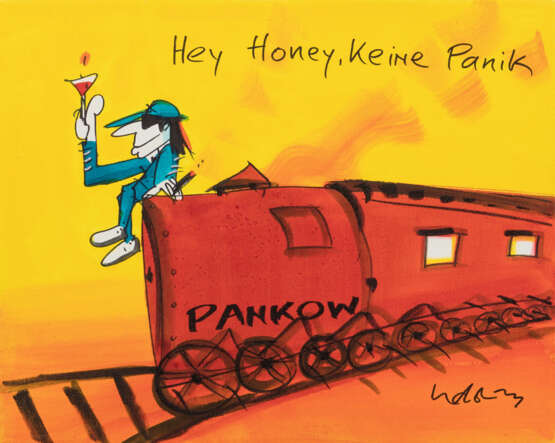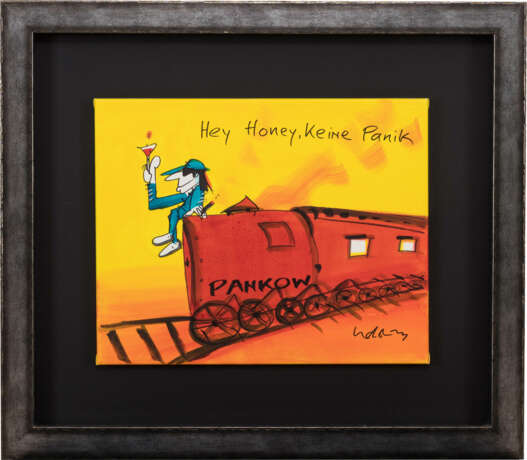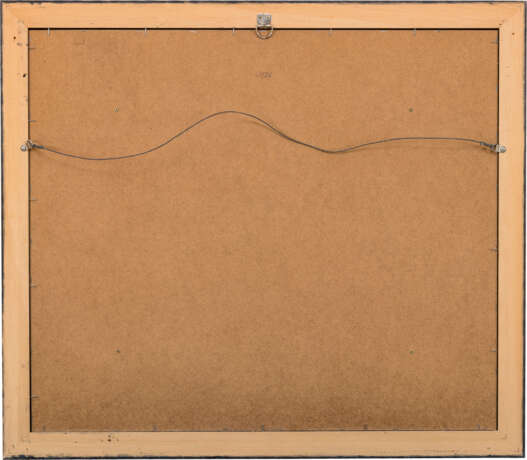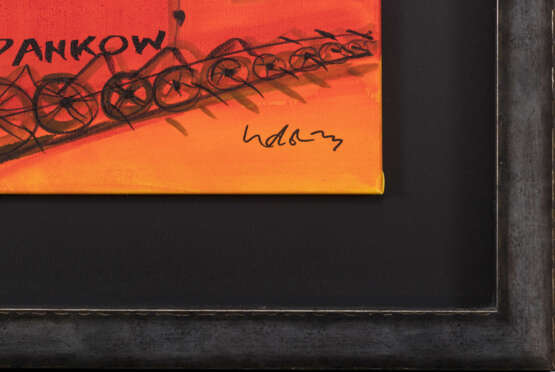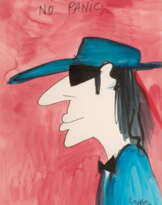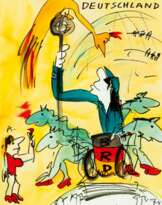ID 847316
Lot 93 | Udo Lindenberg (1946 Gronau)
Estimate value
€ 5 000
'Sonderzug - Hey Honey, keine Panik', Mischtechnik und Acryl auf Leinwand, 39,5 cm x 50 cm, signiert, 2011 (laut Zertifikat), betitelt, Leinwand montiert, Kopie des Zertifikates anbei, Provenienz: Walentowski Galerien, Hamburg.
In Anlehnung an seinen politischen und kritischen Songtext "Sonderzug nach Pankow", gestaltete Udo Lindenberg das Gemälde "Hey Honey, keine Panik". In leuchtenden Rot- und Gelbtönen rast der Sonderzug Richtung Berlin-Pankow. Oben auf der Lok: Udo Lindenberg, lässig sitzend, verschmitzt lächelnd, im typischen Outfit, mit einer Zigarre und einem Gläschen Likör in der Hand. Charakteristisch für die Malerei Lindbergs ist sein außergewöhnlicher Malstil. Eine Mischung aus Cartoon und Karikatur mit prägnanten Schriftzügen und knalligen Farben, hier ausgeführt mit verdünnten Aquarellfarben. Besonders prägnant ist die starke Farbbrillanz in der das witzig anmutende, doch sehr tiefgründige Motiv, vom Künstler dargestellt wird. Sein Kulthit "Sonderzug nach Pankow" ist politisch aufgeladen und eng mit der deutschen Geschichte verwoben. Nachdem das DDR-Regime 1979 Lindenbergs Wunsch, in der DDR auftreten zu dürfen, ablehnte, kam der Rockmusiker 1983 auf die Idee, als Reaktion auf diese Ablehnung das Lied "Sonderzug nach Pankow" zu veröffentlichen. In dem Song wendet er sich direkt und in ironischer Weise an den damaligen Staatsratsvorsitzenden Erich Honecker. Lindenberg stellt Honecker als einen scheinheiligen Mann dar, welcher zwar in der Öffentlichkeit die Ideologie der Regierung präsentiere, innerlich jedoch heimlich West-Radio höre: "Honey, ich glaub', Du bist doch eigentlich auch ganz locker. Ich weiß, tief in dir drin, bist Du eigentlich auch?n Rocker." Udo Lindenbergs Konfrontationskurs hatte Erfolg. Noch im selben Jahr kam es zum ersten und bis zur Wende einzigen Auftritt von Lindenberg in der DDR.
Udo Lindenberg (1946 Gronau)
'Sonderzug - Hey Honey, keine Panik', mixed media and acrylic on canvas, 39,5 cm x 50 cm, signed, 2011 (according to certificate), titled, canvas mounted, copy of certificate enclosed, Provenance: Walentowski Galleries, Hamburg.
In reference to his political and critical song lyrics ''Sonderzug nach Pankow'', Udo Lindenberg created the painting ''Hey Honey, keine Panik''. In bright shades of red and yellow, the train speeds towards Berlin-Pankow. On top of the locomotive: Udo Lindenberg, casually seated, smiling mischievously, in his typical outfit, with a cigar and a glass of liqueur in his hand. Characteristic of Lindberg's painting is his unusual style of painting. A mixture of cartoon and caricature with concise lettering and bright colours, here executed with diluted watercolours. Particularly striking is the strong brilliance of the colours in which the artist depicts the witty yet very profound motif. His cult hit ''Sonderzug nach Pankow'' is politically charged and closely interwoven with German history. After the GDR regime refused Lindenberg's request to perform in the GDR in 1979, the rock musician came up with the idea of releasing the song ''Sonderzug nach Pankow'' in 1983 as a reaction to this rejection. In the song, he addresses the then Chairman of the Council of State Erich Honecker directly and in an ironic way. Lindenberg portrays Honecker as a hypocritical man who presents the government's ideology in public but secretly listens to West German radio: ''Honey, I think you're actually quite relaxed too. I know, deep down inside, you're actually a rocker too.'' Udo Lindenberg's confrontation course was successful. In the same year, Lindenberg made his first and, until the fall of the Wall, only appearance in the DDR.
| Artist: | Udo Lindenberg (1946) |
|---|---|
| Auction house category: | Drawings & Pastels |
| Artist: | Udo Lindenberg (1946) |
|---|---|
| Auction house category: | Drawings & Pastels |
| Address of auction |
WETTMANN | Auktionshaus an der Ruhr Friedrichstraße 67-67a 45468 Mülheim an der Ruhr Germany | ||||||||||||||
|---|---|---|---|---|---|---|---|---|---|---|---|---|---|---|---|
| Preview |
| ||||||||||||||
| Phone | +49 (0)208 3059081 | ||||||||||||||
| Fax | +49 (0)208 4391735 | ||||||||||||||
| Buyer Premium | 30% | ||||||||||||||
| Conditions of purchase | Conditions of purchase | ||||||||||||||
| Business hours | Business hours
|
